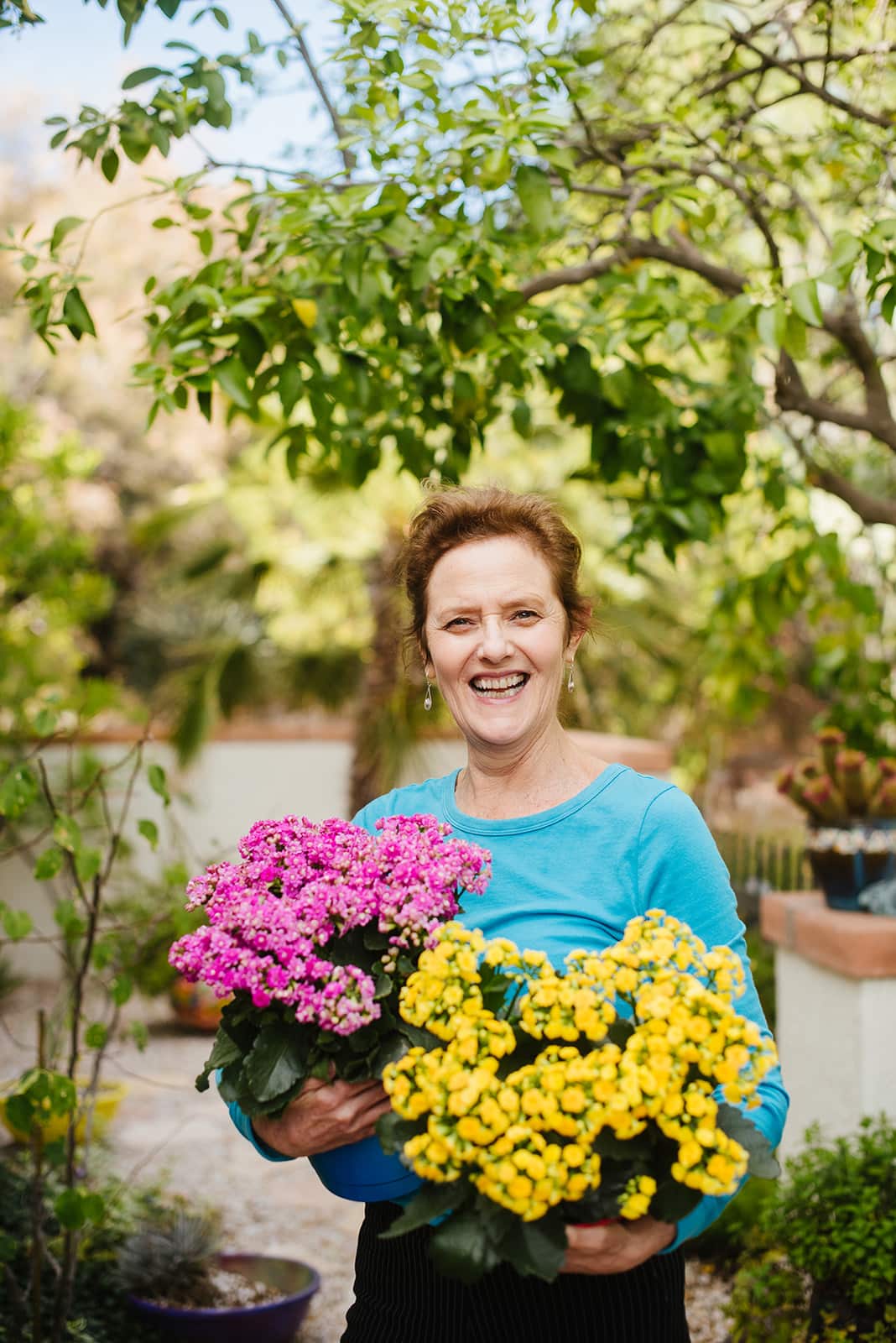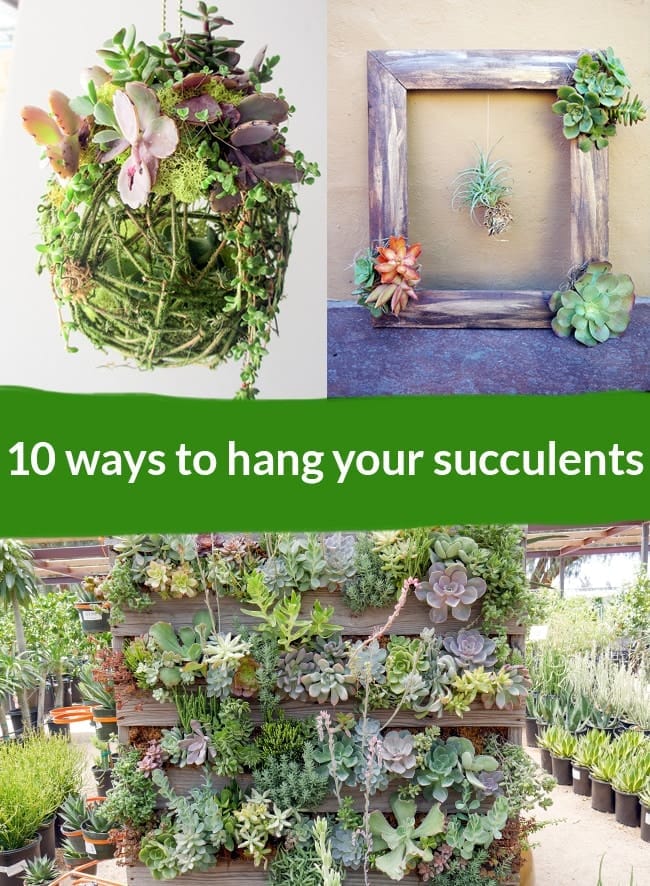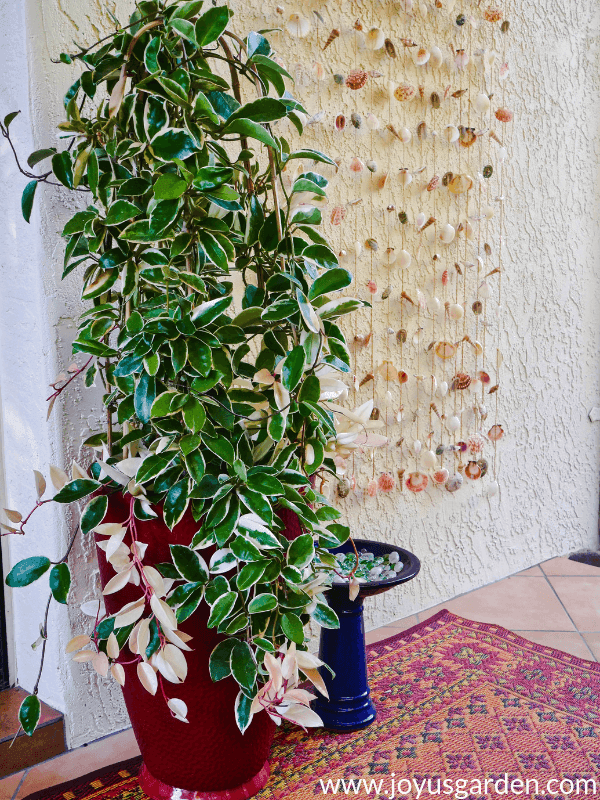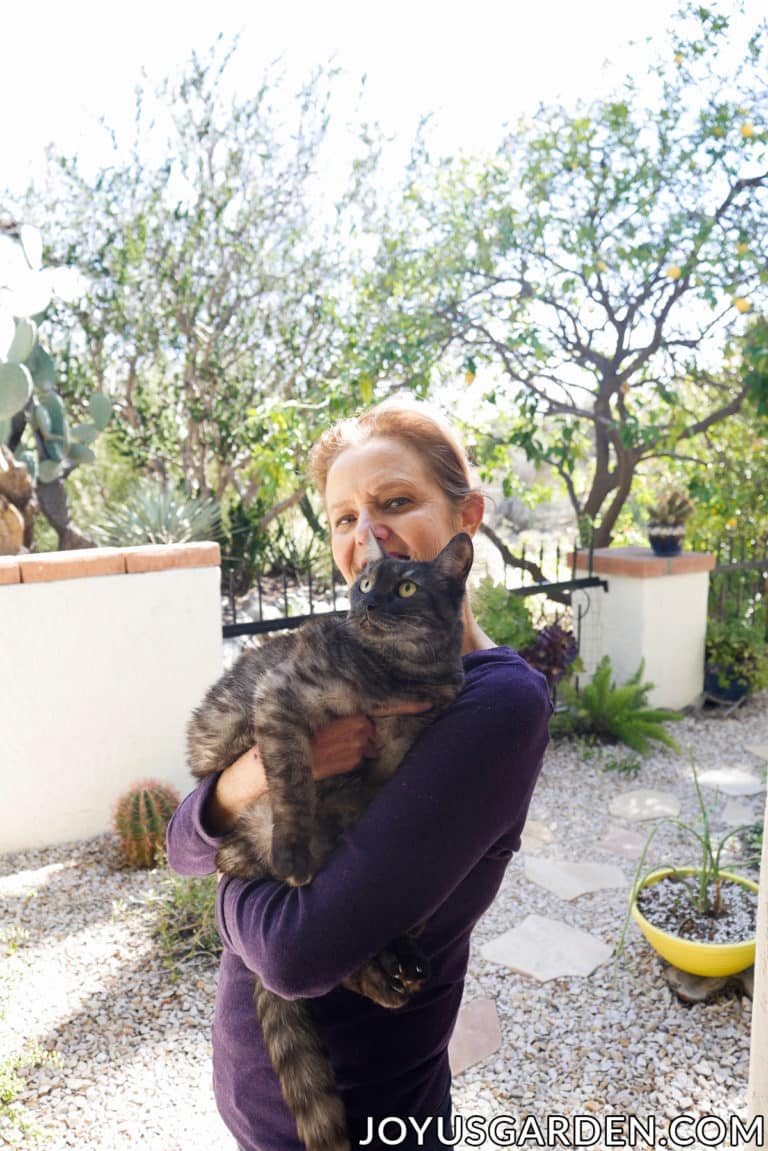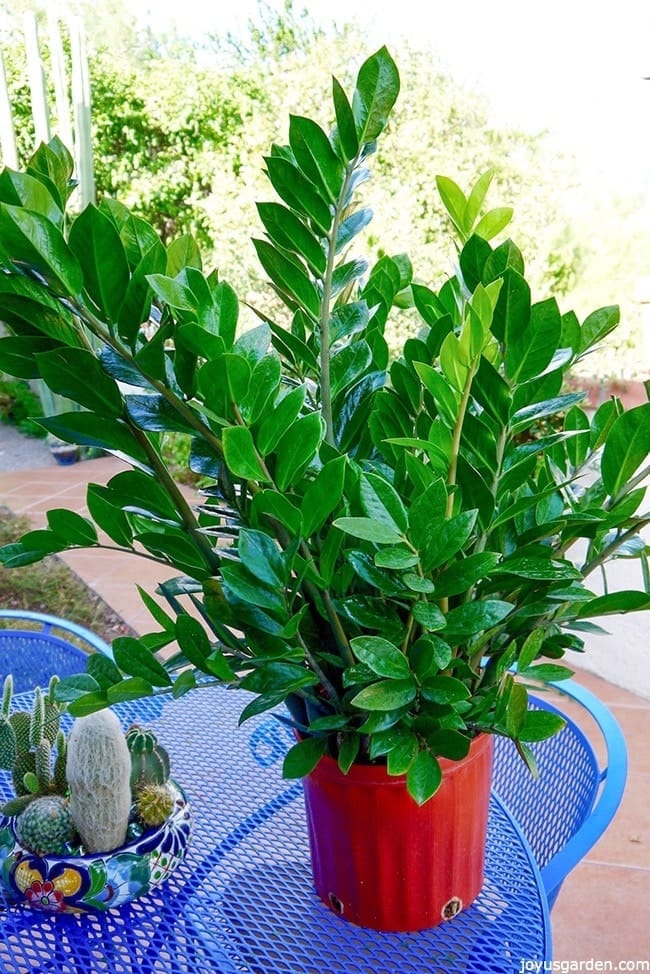Impatiens Plants: A Care & Planting Guide
If you want to brighten up a flower bed, you can’t go wrong with impatiens plants. I have a lot of experience with planting impatiens and impatiens care. This was the most popular bedding plant when I was a professional gardener in the San Francisco Bay Area.
There are many different impatiens plants the world over. This post is focused mainly on Impatiens walleriana commonly called just Impatiens or Busy Lizzies.
About Impatiens Plants
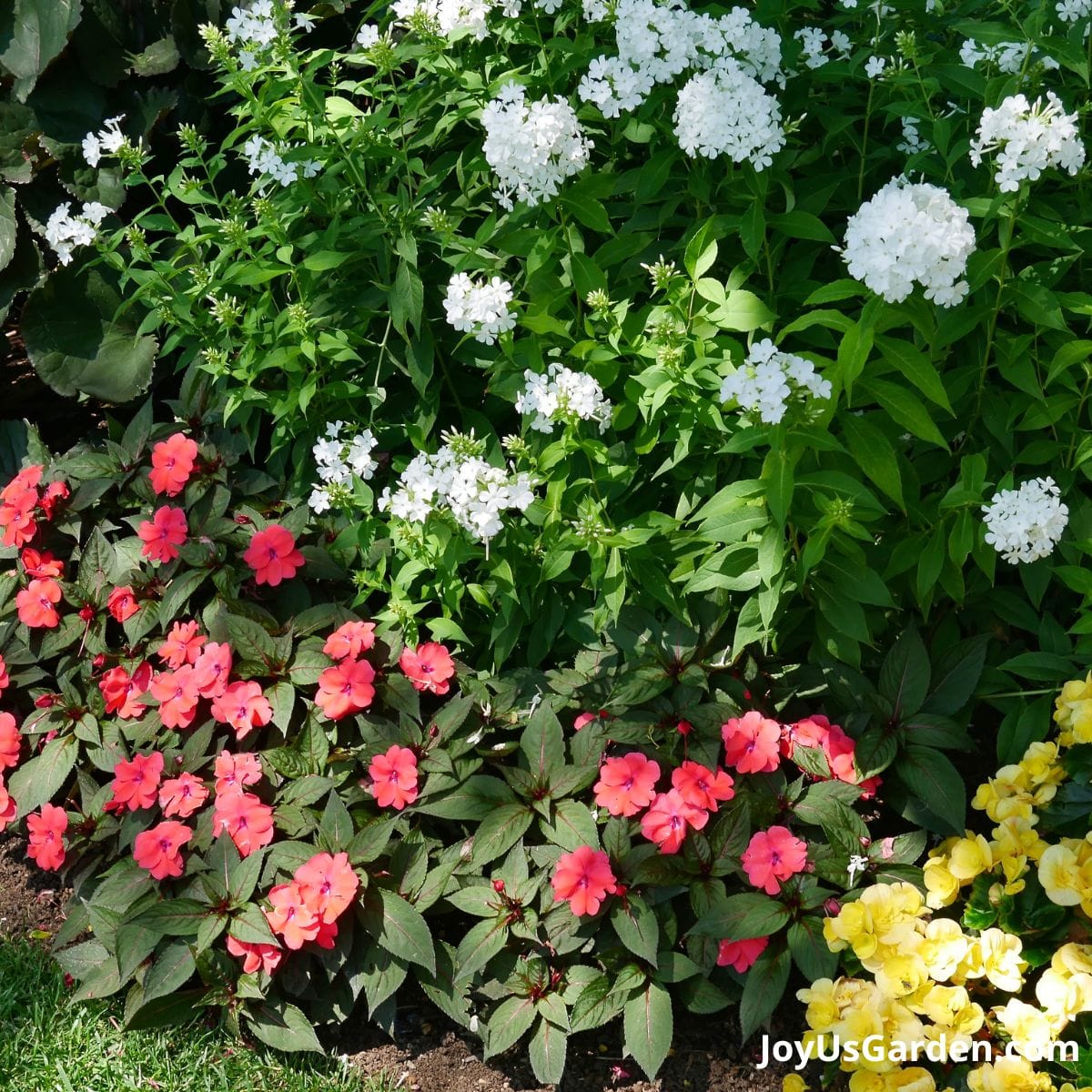
Types Of Impatiens
The most common impatiens plants sold are the Impatiens walleriana (Busy Lizzie) and the Impatiens hawkeri (New Guinea Impatiens). Both these impatiens are easy to care for and give you non-stop color for the entire growing season.
Not only do these impatiens bloom non-stop throughout the season, but their blooms are profuse as well. Both of these types can be grown in partial shade or bright shade, as container plants or bedding plants. The New Guinea Impatiens are more sun tolerant.
There is a wide variety of Impatiens wallerianas on the market now. Accent, Dazzler, Super Elfin, and Fiesta are among the most popular and if you click on the links, can see they grow to be different sizes.
Other types of impatiens I’ve planted or seen growing are the Impatiens balfourii (you’ll see this one in the very last photo), i. balsamina, and i. capensis.
Impatiens Plant Colors
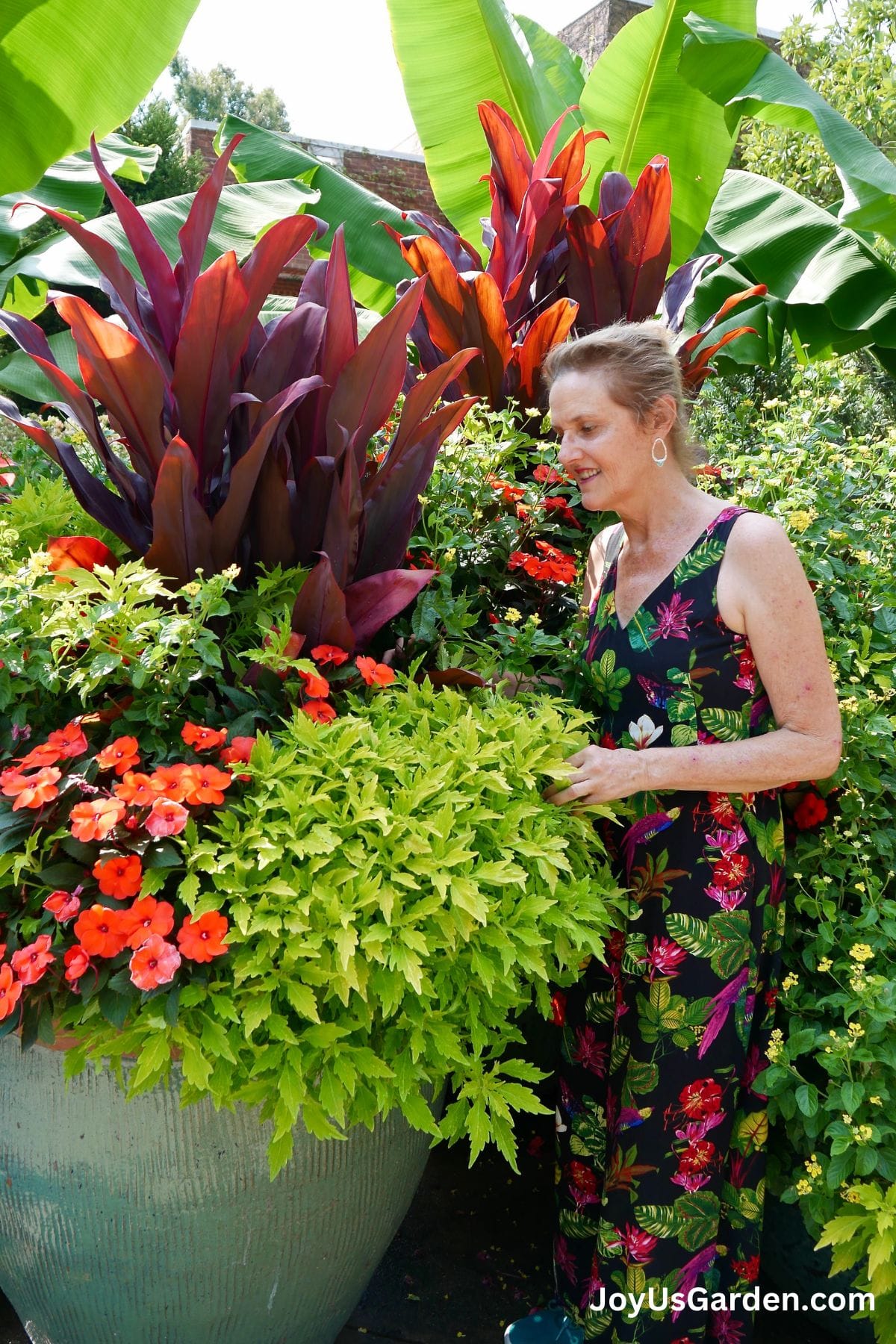
A big draw to impatiens besides their profuse blooms is the variety of colors you can find them in. They’re available in red, purple, pink, white, orange, salmon, and many bi-color combos.
The Rosebud Impatiens have double flowers that resemble miniature roses. Their wide range of colors makes them that much more sought after.
Impatiens Size
Some varieties stay a more compact plant reaching 10″, whereas others can grow up to 15-20″ by the end of the growing season. They tend to grow in mounding habit making them beautiful in flower beds as well as containers. The New Guinea Impatiens can reach around 18″ tall.
They’re most commonly sold as container-grown plants in 6-packs, 4″, and 1-gallon sizes. For the New Guinea Impatiens, it’s 4″ and 1-gallon pots.
Impatiens can also be grown from seed.
It’s important to have a good seed starting mix and even better if you make your own. Here’s a DIY Seed Starting Mix Recipe
Planting Impatiens
Time Of Year For Planting
Impatiens don’t tolerate cold temperatures so the best time for planting is after the last frost date when the soil temperatures warm. They start appearing in garden centers and big box stores in spring much to the delight of us gardening aficionados.
I grew up in Connecticut (zone 6a) where we would start planting impatiens in mid-May. I would begin to plant impatiens for my clients in the Bay Area (zone 10a, 10b) in early April. You can find your growing zone here and your last frost date here.
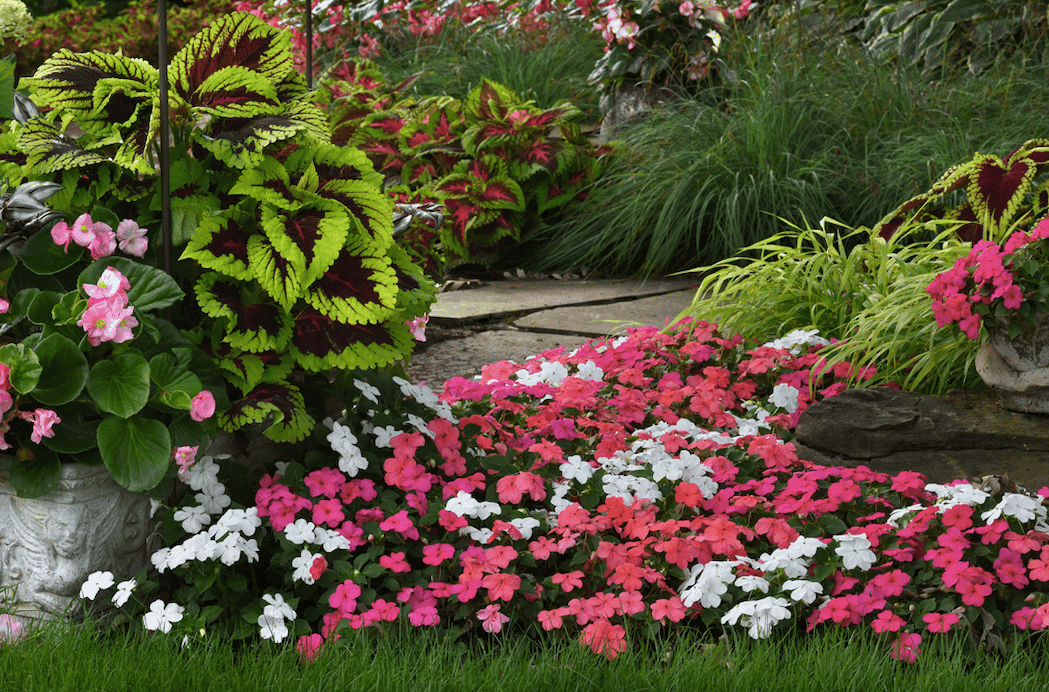
Companion Plants For Impatiens Plants
To add some variety to your garden and landscape, impatiens are commonly planted alongside other plants. In the gardening trade, I would plant impatiens with begonias, lobelia, alyssum, ipomoea, bacopa, coleus, ivy, nemesia, fuchsia, Japanese forest grass, and lysomachia goldilocks.
Busy Lizzies and New Guinea Impatiens are beautiful in container gardens mixed with other plants.
Container Size
For one plant you can choose an 8″ to 12″ pot. Impatiens have a fine root system so no need for anything bigger.
For a mixed planting, you’ll want to go larger. Choosing a container size will depend on how many and what plants you are planting. As a general rule of thumb, 5-6 annuals is a good number to plant in a 16″ pot. I always spaced impatiens 10-14″ apart, depending on the variety.
Impatiens do well in low bowl plantings also. Just know that the smaller or lower the container, the more you’ll need to water it.
Container Type/Container Material
Impatiens have done well in every type of container I’ve planted them in. They’ve grown equally well in low bowls, hanging baskets, planter boxes, window boxes, urns, and flower pots.
As far as container material goes, the same versatility applies. I’ve planted them in plastic, fiberglass, terracotta, ceramic, cement wood, moss, and coir baskets.
Although Impatiens are not technically trailing plants, they look great mounding over the sides in hanging baskets.
Do you enjoy container gardening? We have many many helpful posts on Container Gardening.
Impatiens Plants Growing In Pots
Impatiens are well suited to growing in pots. They look great growing on their own or mixed with other plants. In what location you choose to grow them depends on your climate zone. The “Exposure” category below will help you out with this.
When planting in a pot, choosing a pot with drainage holes is important. Plant your impatiens in good-quality potting soil formulated for container planting. Impatiens have fine roots and you want to plant them in a mix the roots can easily grow into.
You also want the mix to be well draining and on the lighter side so that excess water flows out. Remember, impatiens don’t like to dry out, but they don’t want to be kept consistently soggy either!
Don’t sink the root ball too far into the soil when planting. You want the top of the rootball to sit level with the top of the mix you’re planting into. Because I always added an inch or so of compost as a topdressing, I adjusted for this by having the top of the rootball even with the compost.
Because impatiens bloom so much and for so long, they need feeding. I was a professional gardener in the San Francisco Bay Area for over twenty years and this was my favorite blend when planting in pots: 2 parts rose and flower food / 1 part alfalfa meal / 1 part chicken manure.
I still use this mixture when planting flowering annuals and perennials except I add worm compost instead of chicken manure. How much of this blend you use depends on the size of the plant. When planting a 4″ plant, I’d mix in a scant handful of the blend.
How close you plant your impatiens depends on the look you want and the type you’re planting. A general rule is 1 plant in an 8-12″ pot, and 5-6 plants in a 16″ pot. You want to space them about 10″ apart.
Adding a layer of compost on top will not only help nourish the plants but also help to keep the moisture in. Annuals have a shallow root system and will dry out quickly, especially if you live in a climate where summer rains aren’t a common occurrence.
You want to make sure your impatiens plants are watered before you plant them, and water the container after planting.
Impatiens Soil Mix
This pertains to impatiens growing in pots. I touched on this above, but want to go a bit more in-depth here because the soil is the foundation of any plant’s health.
Impatiens have fine roots so you want to have them in a mix the roots can easily grow into. They like good quality potting soil with organic matter (compost) mixed in and used as a top dressing. Working in an organic matter not only helps feed the roots, but also will help with drainage.
The two potting soils I use regularly for potted plants growing indoors and outdoors are Happy Frog and Ocean Forest. Both are formulated for growing in containers and sometimes I use one or the other, and sometimes I mix them.
You can make your own compost, or there are some good brands already bagged you can buy. They contain different materials but all help to feed the roots. If you go to your local landscape supply company, they will most likely have a compost well suited for what you’re growing in your area. In case you’re interested, I buy my compost at our farmer’s market.
A layer of compost on the top will not only help to feed, but also conserve water especially if you’re in a dry climate like where I live in Arizona or used to in California.
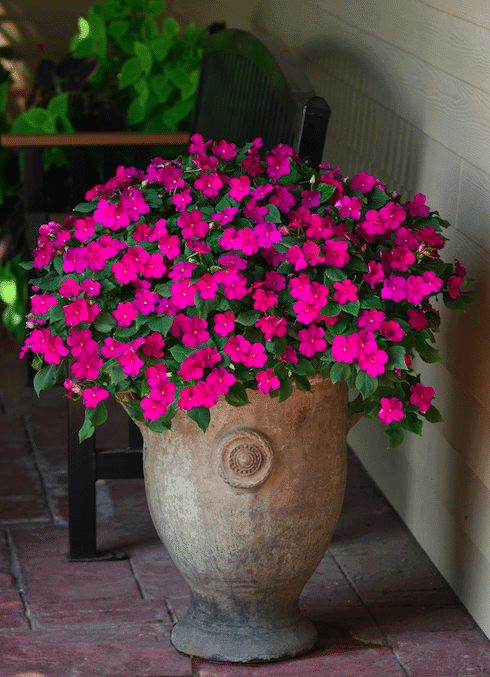
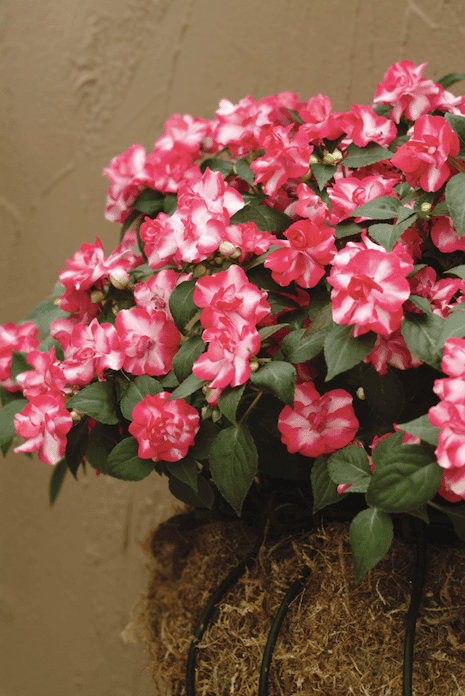
Planting Impatiens In Garden Beds
Impatiens are one of the most common plants to use in flower beds. They’re stunning in mass plantings and mixed with other annuals and perennials.
The most important thing (along with exposure/location) is soil prep. Because impatiens have shallow, fine roots, it’s important to work and amend the soil so those fine roots can grow.
You need healthy soil in order for the plants to do well. It’s the foundation for your plants to bloom and grow. You want it to be well amended with organic matter (like compost), have good drainage, and be as rich as can be.
If your soil is composed of a good amount of clay, you’ll amend it differently than if your soil has a lot of sand or sandy loam. Your local landscape supply company or nursery will be able to advise you on what amendments are right for your garden and what you’re planting.
If you have multiple beds or a large area to plant, buying soil and/or amendments in bulk from a local landscape supply company and having it delivered is the most economical way. This applies when you’re feeding new or top-dressing established beds.
For small beds, the bagged option is the way to go. In fact, many landscape supply companies let you bag your own so you get compost specific to your area and the plants you’re growing. You can see what I mean here.
Don’t sink the root ball too far into the soil when planting. You want the top of the rootball to sit level with the top of the mix you’re planting into. Because I always added an inch or so of compost as a topdressing, I adjusted for this by having the top of the rootball even with the top of the compost.
This is the blend I use when planting impatiens in pots or in the ground: 2 parts rose and flower food / 1 part alfalfa meal / 1 part chicken manure. How much you use depends on the size of the plant. When planting a 4″ plant, I’d mix in about a scant handful of the blend.
You want to make sure your impatiens are watered before you plant them, and water the container after planting.
We go more into depth in our Organic Flower Gardening Post on planting in flower beds and other things to know. This post on Preparing and Planting a Flower Bed is very old but you might find a useful tip or 2 in it.
Impatiens Plant Care
Exposure
How much sun impatiens can take depends on your climate zone, the intensity of the sun, and the location where they’ll be growing. Part shade with bright light is their sweet spot for looking good and flowering away ike the champs they are.
Impatiens will let you know if they’re not happy. If they’re growing in a shady spot and not getting enough light, the growth will become leggy and the flowers will be smaller or non-existent.
Impatiens have succulent stems which are full of water. They’ll burn in the direct, hot sun and will need full or afternoon shade. In a location with cooler summers, full sun is fine. The cool sun is totally different from the hot sun.
Some of the newer varieties are now being bred to tolerate more sun. The New Guinea Impatiens can take more sun and have bigger blooms. They also do well in humid weather.
A good sign that impatiens will do well for you is if your neighbors or the business down the street are growing them successfully, then they’ll do fine in a similar location in your garden!
Are you interested in what flowering plants will do well in full sun? Check out our list of Annuals For Full Sun.
Growing On The Coast Of California VS A More Sunny Area
I was born in New England, spent thirty years on the coast of California (Santa Barbara and San Francisco), and now live in Tucson, Arizona. Different growing zones, that’s for sure!
When I worked on the California coast, we could plant impatiens in full sun. Because of the morning and evening fog, the duration of the sun’s intensity is shorter. Now that I live in Tucson I don’t grow impatiens because the sun and heat are too intense and would fry them in a heartbeat!
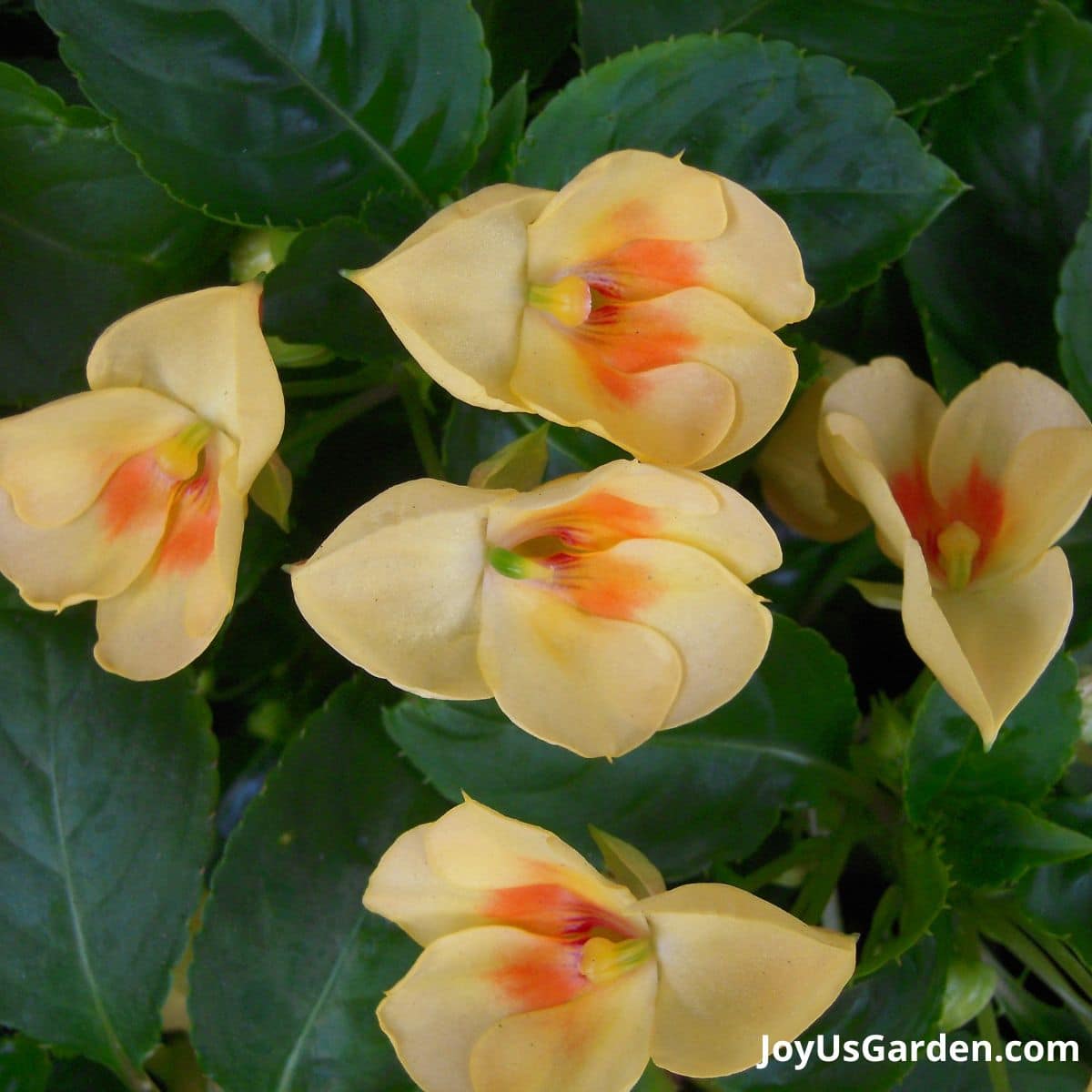
Watering Impatiens Plants
Impatiens prefer a happy medium when it comes to watering. You don’t let them dry out because they’ll go completely down. Conversely, their stems are full of water so frequent watering (like every day or two), will cause them to damp off. If you’re in a high-humidity climate and the soil stays too damp, this could also lead to powdery mildew.
Even though they don’t like to dry out completely, too much water isn’t good either. Slightly moist soil is their happy spot, not soggy soil. A rich, yet well-drained soil will help with this.
How often you water impatiens depends on the weather, pot size, and soil composition. In dry, warm spells, they’ll need watering more often.
They’ll let you know if they’re not happy. When they start to look droopy and sad and completely dry out, they’ll come back if you catch it asap and water. I know this from experience!
Feeding/Fertilizing Impatiens Plants
Impatiens flower non-stop for many months. It takes a fair amount of energy to keep those blooms abundant. Adding compost when you plant helps, and so does fertilizing.
There are many options on the market depending on how you prefer to feed. You can go with a slow-release fertilizer, a water-soluble fertilizer (you’ll need to do this more often), or one you work into the soil.
I use the same fertilizer for annuals as I do for roses. It’s a blend of organic rose and flower food, alfalfa meal, and composted chicken manure or worm compost that I work into the soil. This organic blend breaks down slower and lasts longer.
The formula is: 2 parts rose and flower food, 1 part alfalfa meal, and 1 part chicken manure. I still use this mixture except I now add worm compost instead of chicken manure.
In California, I would apply this blend upon planting and then again in mid-summer. If you do not use compost, you may need to fertilize a bit more often depending on what you use.
I avoid chemical fertilizers. The rose and flower food brands I prefer are Dr. Earth, E.B. Stone, and my favorite Down to Earth.
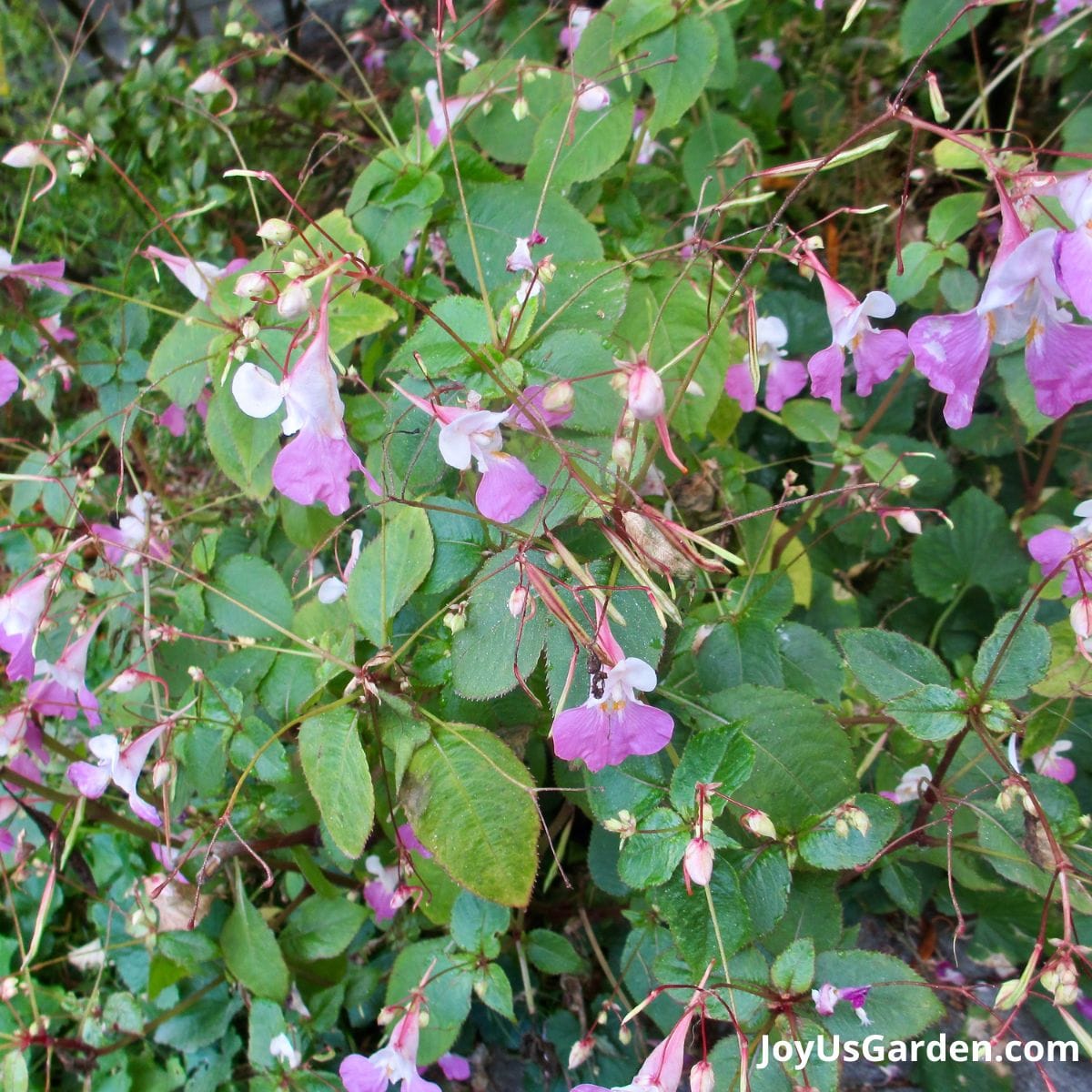
Pinching/Deadheading
I’ve found the New Guinea Impatiens don’t require pinching because they have more of a dense growth habit. Some of the taller growing Busy Lizzies get a bit leggy towards the end of the season and a round of tip pruning or pinching to shape will help. Pruning those leggy stems in late summer will keep them looking more attractive into fall.
The impatiens hybrids or cultivars that stay tighter and more compact don’t need pinching. By the way, the identification tag in the grow pot should tell you what cultivar or hybrid you’re getting and what size it reaches.
No need to be concerned with deadheading. Impatiens flowers will shed on their own but you can always give the plant a bit of shake and the spent blooms will fall right off.
Problems Growing Impatiens Plants
Impatiens are susceptible to fungal diseases. One is downy mildew which can spread rapidly from plant to plant and into the soil. In 2013 the San Francisco Bay Area experienced a downy mildew “attack” and Impatiens wallerianas were dying in droves. Suddenly, none were to be found in any of the nurseries.
Nothing provides non-stop color but as substitutes, we planted wax begonias, nemesia, lobelia, nicotiana, and alyssum. If that’s a concern, be sure to check out the Beacons Impatiens with downy mildew resistance.
They can also be susceptible to powdery mildew, especially in areas with high humidity and cooler evenings.
I’ve never seen any with spider mites or aphids, but know they can be susceptible to them.
Conclusion: Impatiens are one of the most popular bedding plants to use in flower gardens and containers. They do best in bright shade or filtered light out of the direct hot sun and prefer to be kept evenly moist. For non-stop blooms over a long period of time, you can’t find anything better!
Happy Gardening,

This post may contain affiliate links, you can read our policies here.
- About the Author
- Latest Posts
Nell, the founder of Joy Us garden, was born into a gardening family and grew up in Connecticut’s countryside. After living in Boston, New York, San Francisco, & Santa Barbara, she now calls the Arizona desert home. She studied horticulture & garden design, working in the field all her life. Nell is a gardener, designer, blogger, Youtube creator, & author. She’s been gardening for a very long time & wants to share what she’s learned with you.
